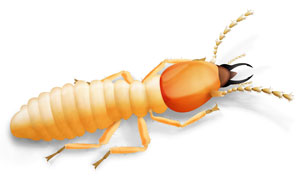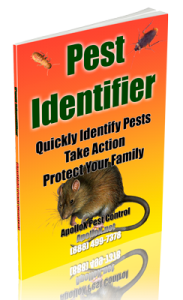Drywood Termites – Serious Problem
 Drywood termites are pale to dark brown in color and about 1/4 to 1/2 inches long. Unlike subterranean termites, drywood termites do not need moisture. They don’t need to have their base colony underground nor do they need to create mud tubes from the ground into your home.
Drywood termites are pale to dark brown in color and about 1/4 to 1/2 inches long. Unlike subterranean termites, drywood termites do not need moisture. They don’t need to have their base colony underground nor do they need to create mud tubes from the ground into your home.
This creates two issues:
- Harder to discover: First, without the tale-tale mud tubes characteristic of subterranean termites, or a highly visible winged invasion, drywood termites may not be as easily discovered in your home.
- Greater mobility: Second, drywood termites are more mobile. Here’s a possible scenario: You purchase a beautiful new wooden cabinet, or an antique wooden table. Unknown to you, the wooden furniture is infested with a colony of drywood termites. They were already hidden in the furniture before you brought it into your home. Once inside your home, the drywood termites easily move from the furniture into the framework of your house.
Like subterranean termites, drywood termites destroy wood and can cause irreparable damage to your home.
Drywood Termites – Prevention
One of the best ways to prevent drywood termites from entering into your home is to thoroughly inspect all wood that you bring into your home. This includes all wooden furniture and wood used in remodeling jobs (i.e. wooden flooring to replace an existing floor, new wooden siding, the wood used in a new addition to your home…etc.). You can ask for a certificate of termite inspection when purchasing wood that will enter your home.
Termites hate citrus. It drives them away. When cleaning any exposed wood inside your home, use citrus-based cleaners.
Drywood Termites – Discovery
As we said, drywood termites may be harder to discover than subterranean termites–but not impossible. Look for the dark fecal pellets they push outside their living area. These will eventually form small piles.
Do not assume that the drywood termites have only remained in the new wooden furniture. By the time you discover them, they could have already moved out of the furniture and into the wooded structure of your home. If you suspect drywood termites, call a licensed termite exterminator to confirm the presence of the termites.
Call ApolloX Pest Control
(888) 499-7378
Drywood Termites – How to rid your home of an infestation.
There are basically 2 ways to exterminate drywood termites: Chemicals and Heat
- Chemicals: These will usually be in the form of poisonous gas used to fumigate all or part of your home. Chemical injections can also be used, especially if your are absolutely certain the infestation is well localized in a smaller area. It is highly recommended that you call on the services of a licensed termite exterminator to ensure chemicals are safely employed.
- Heat: As with bed bugs, heat also kills drywood termites. The infested area will need to be tented, then brought up to the required temperature for the recommended period of time. The advantage of using heat is that there is no toxic gas or liquid substance in your home. The disadvantage is that if improperly applied the heat may be ineffective. You want to ensure that all the termites are killed, for any stragglers could continue to spread and do further damage to your home.
Drywood Termites – Better safe than sorry.
Considering the damage drywood termites can cause to your home (they’re like a smoldering fire), it’s a good idea to schedule a periodic termite inspection by a licensed termite exterminator every few years.
Call ApolloX Pest Control
(888) 499-7378
Article Inspiration From: http://killtermitesyourself.com/how-to-kill-drywood-termites/












Recent Comments